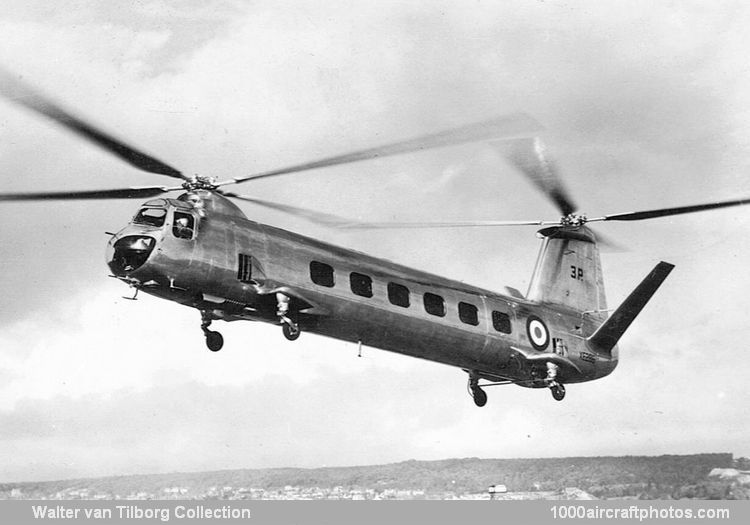12/31/2009. Remarks by Johan Visschedijk: "The Bristol Type 173, the first British two-engined twin-rotor helicopter, was developed to Ministry of Supply (MoS) Specification E.4/47, and work on two prototypes began in 1948. The all-metal machine had a cabin section with five large windows each side, a large tail pylon, a large V-tail plane, and a fixed four-leg landing gear. The two-crew nose compartment, control systems, transmission system, three-blade rotor assemblies and engine installation were similar to those on the Type 171 Sycamore.
Power was provided by a 520 hp Alvis Leonides 73 piston engine at each end of the fuselage with inter-connected gearboxes to ensure that either engine would provide power in the event of a single-engine failure. Ground trials and tethered flights with the first prototype, G-ALBN c/n 12871, were started in May 1951 and soon ground resonance was encountered. This was cured by linking the right- and left-hand oleo-struts of the landing gear by small-bore hydraulic piping.
The aircraft eventually made its maiden flight on January 3, 1952. In 1953 it was allotted the s/n XF785 and was transferred to the Admiralty for naval trials. XF785 was relegated to a ground instructional airframe (7648M) in the late fifties, while ownership was transferred to the RAF on July 21, 1960. Subsequently it was stored till it was transferred to the Bristol Aero Collection at Kemble, Gloucestershire on January 3, 2002.
The second prototype, finished in British European Airways (BEA) livery and designated Type 173 Mark 2, G-AMJI c/n 12872, was flown August 31, 1953. This was fitted with a revised landing gear with castoring front wheels and fixed rear wheels and had small stub wings fore and aft, with winglets on the tips of the aft wings.
Carrying the s/n XH379 this aircraft also undertook naval trials, whereafter it was reverted to the Vee tail plane configuration of the first prototype. Again registered G-AMJI it was delivered to BEA on July 20, 1956, named 'Sir Bors', but was returned to the MoS on September 11, 1956. Subsequently it was involved in a landing accident and written off.
Meanwhile an additional three prototypes Type 173 Mark 3, c/n 13204 to 13206, had been ordered by the MoS, these were powered by 850 hp Alvis Leonides Major engines and fitted with four-blade rotors, these rotors being retrofitted to the first prototypes as well. Initially registered as G-AMYF to G-AMYH, these registration were not taken up, instead the aircraft were allotted the s/n XE286 to XE288 respectively. However, only the latter was flown, the former two being relegated to ground testing.
The type was not taken into production, however, a development, the Type 192 Belvedere, eventually served with the RAF."
